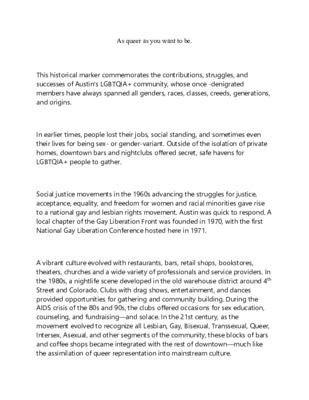2.2 - As queer as you want to be — original pdf
Backup

As queer as you want to be. This historical marker commemorates the contributions, struggles, and successes of Austin's LGBTQIA+ community, whose once -denigrated members have always spanned all genders, races, classes, creeds, generations, and origins. In earlier times, people lost their jobs, social standing, and sometimes even their lives for being sex- or gender-variant. Outside of the isolation of private homes, downtown bars and nightclubs offered secret, safe havens for LGBTQIA+ people to gather. Social justice movements in the 1960s advancing the struggles for justice, acceptance, equality, and freedom for women and racial minorities gave rise to a national gay and lesbian rights movement. Austin was quick to respond. A local chapter of the Gay Liberation Front was founded in 1970, with the first National Gay Liberation Conference hosted here in 1971. A vibrant culture evolved with restaurants, bars, retail shops, bookstores, theaters, churches and a wide variety of professionals and service providers. In the 1980s, a nightlife scene developed in the old warehouse district around 4th Street and Colorado. Clubs with drag shows, entertainment, and dances provided opportunities for gathering and community building. During the AIDS crisis of the 80s and 90s, the clubs offered occasions for sex education, counseling, and fundraising—and solace. In the 21st century, as the movement evolved to recognize all Lesbian, Gay, Bisexual, Transsexual, Queer, Intersex, Asexual, and other segments of the community, these blocks of bars and coffee shops became integrated with the rest of downtown—much like the assimilation of queer representation into mainstream culture. With many of the political and social dreams of the leaders of past decades realized, Austin remains a vibrant place for all communities to call home.